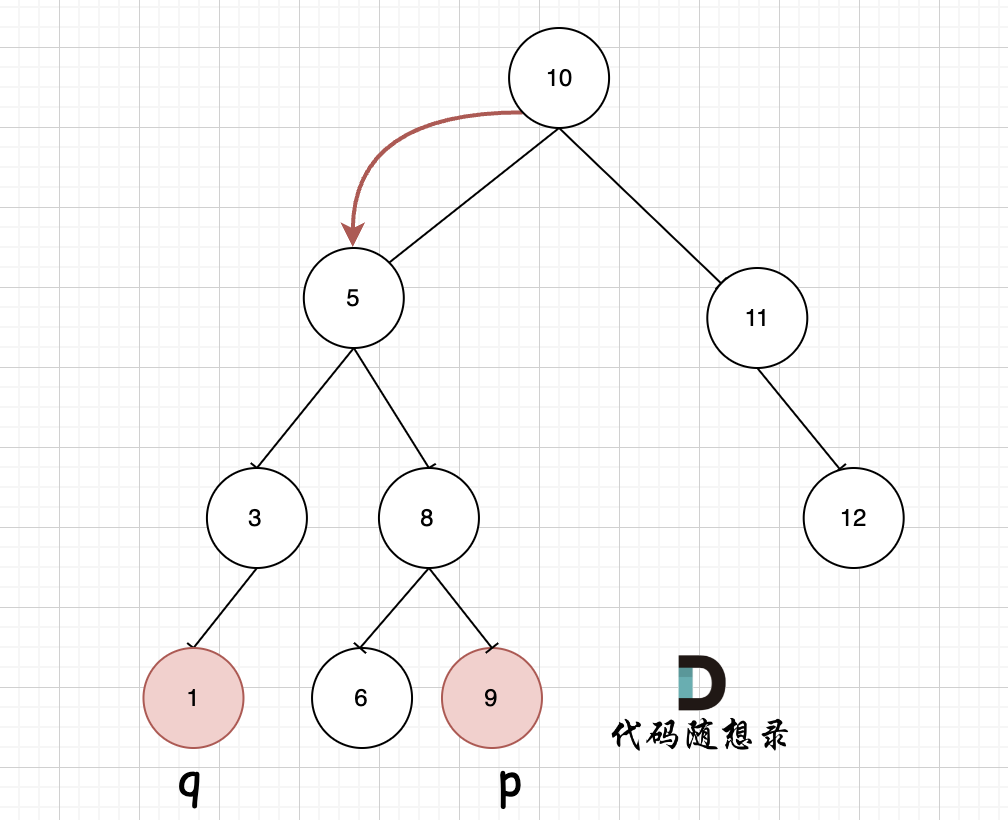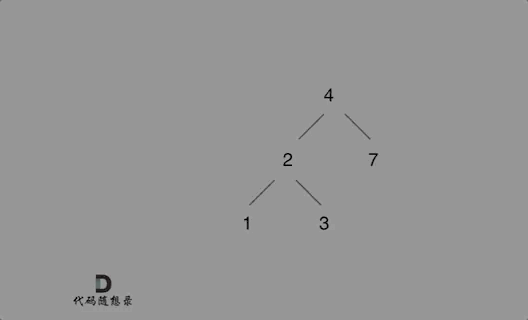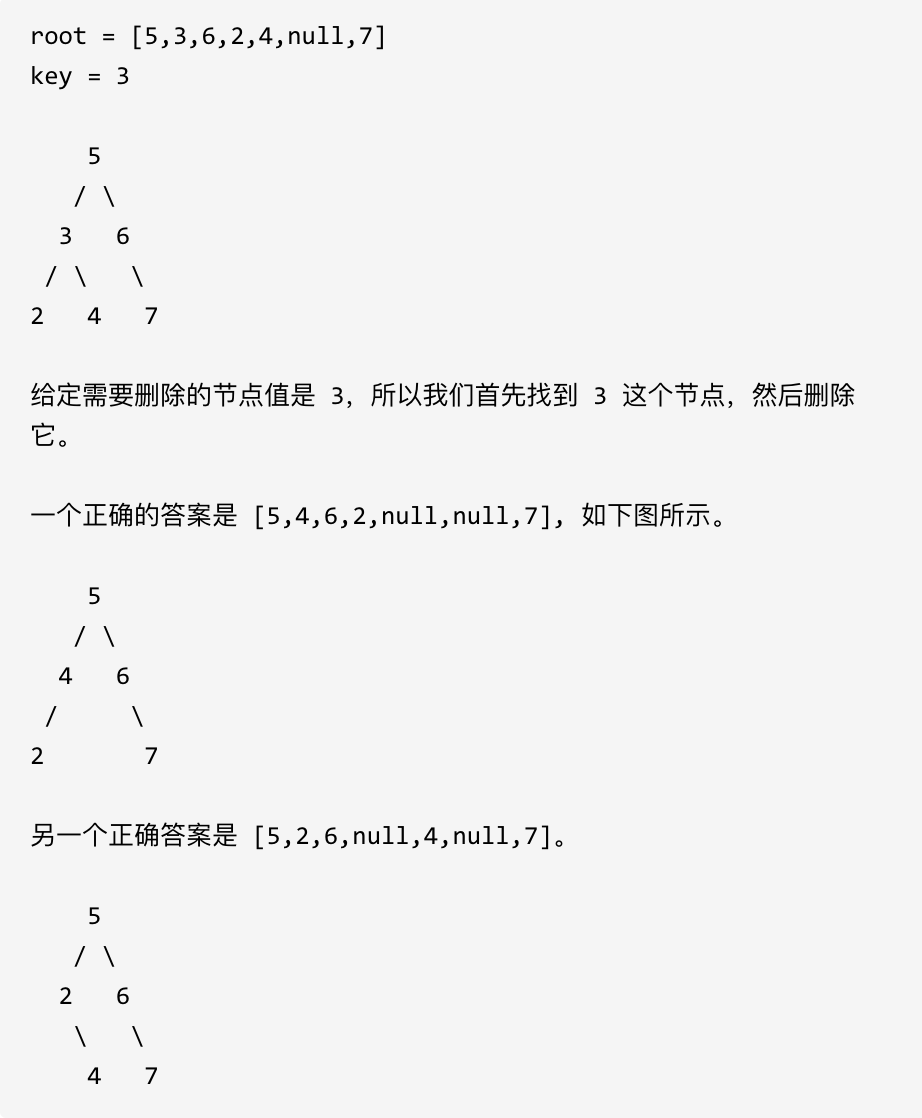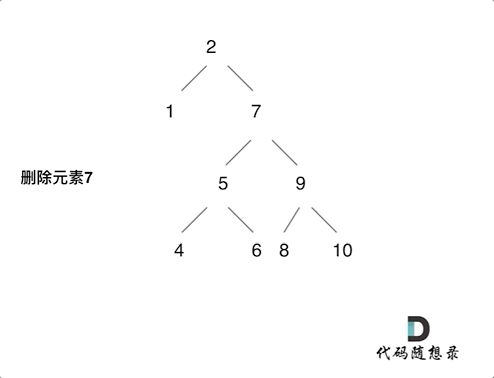代码随想录算法训练营第22天 | 235. 二叉搜索树的最近公共祖先 701.二叉搜索树中的插入操作 450.删除二叉搜索树中的节点
目录
235. 二叉搜索树的最近公共祖先?
给定一个二叉搜索树, 找到该树中两个指定节点的最近公共祖先。
百度百科中最近公共祖先的定义为:“对于有根树 T 的两个结点 p、q,最近公共祖先表示为一个结点 x,满足 x 是 p、q 的祖先且 x 的深度尽可能大(一个节点也可以是它自己的祖先)。”
例如,给定如下二叉搜索树:? root =?[6,2,8,0,4,7,9,null,null,3,5]

示例 1:
- 输入: root = [6,2,8,0,4,7,9,null,null,3,5], p = 2, q = 8
- 输出: 6
- 解释: 节点 2 和节点 8 的最近公共祖先是 6。
示例 2:
- 输入: root = [6,2,8,0,4,7,9,null,null,3,5], p = 2, q = 4
- 输出: 2
- 解释: 节点 2 和节点 4 的最近公共祖先是 2, 因为根据定义最近公共祖先节点可以为节点本身。
说明:
- 所有节点的值都是唯一的。
- p、q 为不同节点且均存在于给定的二叉搜索树中。
💡解题思路
本题是二叉搜索树,二叉搜索树是有序的。
在有序树里,如果判断一个节点的左子树里有p,右子树里有q呢?
因为是有序树,所有 如果 中间节点是 q 和 p 的公共祖先,那么 中节点的数组 一定是在 [p, q]区间的。即 中节点 > p && 中节点 < q 或者 中节点 > q && 中节点 < p。
那么只要从上到下去遍历,遇到 cur节点是数值在[p, q]区间中则一定可以说明该节点cur就是p 和 q的公共祖先。

当我们从上向下去递归遍历,第一次遇到 cur节点是数值在[q, p]区间中,那么cur就是 q和p的最近公共祖先。
💻实现代码
递归法:
class Solution {
public TreeNode lowestCommonAncestor(TreeNode root, TreeNode p, TreeNode q) {
if (root.val > p.val && root.val > q.val) return lowestCommonAncestor(root.left, p, q);
if (root.val < p.val && root.val < q.val) return lowestCommonAncestor(root.right, p, q);
return root;
}
}
迭代法:
class Solution {
public TreeNode lowestCommonAncestor(TreeNode root, TreeNode p, TreeNode q) {
while (true) {
if (root.val > p.val && root.val > q.val) {
root = root.left;
} else if (root.val < p.val && root.val < q.val) {
root = root.right;
} else {
break;
}
}
return root;
}
}
701.二叉搜索树中的插入操作?
给定二叉搜索树(BST)的根节点和要插入树中的值,将值插入二叉搜索树。 返回插入后二叉搜索树的根节点。 输入数据保证,新值和原始二叉搜索树中的任意节点值都不同。
注意,可能存在多种有效的插入方式,只要树在插入后仍保持为二叉搜索树即可。 你可以返回任意有效的结果。

提示:
- 给定的树上的节点数介于 0 和 10^4 之间
- 每个节点都有一个唯一整数值,取值范围从 0 到 10^8
- -10^8 <= val <= 10^8
- 新值和原始二叉搜索树中的任意节点值都不同
💡解题思路
按照二叉搜索树的规则去遍历,遇到空节点就插入节点就可以了。

例如插入元素10 ,需要找到末尾节点插入便可,一样的道理来插入元素15,插入元素0,插入元素6,需要调整二叉树的结构么? 并不需要。。
只要遍历二叉搜索树,找到空节点 插入元素就可以了,那么这道题其实就简单了。
接下来就是遍历二叉搜索树的过程了。
# 递归
递归三部曲:
- 确定递归函数参数以及返回值
参数就是根节点指针,以及要插入元素,这里递归函数要不要有返回值呢?
可以有,也可以没有,但递归函数如果没有返回值的话,实现是比较麻烦的,下面也会给出其具体实现代码。
有返回值的话,可以利用返回值完成新加入的节点与其父节点的赋值操作。(下面会进一步解释)
递归函数的返回类型为节点类型TreeNode * 。
代码如下:
TreeNode* insertIntoBST(TreeNode* root, int val)
- 确定终止条件
终止条件就是找到遍历的节点为null的时候,就是要插入节点的位置了,并把插入的节点返回。
代码如下:
if (root == NULL) {
TreeNode* node = new TreeNode(val);
return node;
}
这里把添加的节点返回给上一层,就完成了父子节点的赋值操作了,详细再往下看。
- 确定单层递归的逻辑
此时要明确,需要遍历整棵树么?
别忘了这是搜索树,遍历整棵搜索树简直是对搜索树的侮辱。
搜索树是有方向了,可以根据插入元素的数值,决定递归方向。
代码如下:
if (root->val > val) root->left = insertIntoBST(root->left, val);
if (root->val < val) root->right = insertIntoBST(root->right, val);
return root;
到这里,大家应该能感受到,如何通过递归函数返回值完成了新加入节点的父子关系赋值操作了,下一层将加入节点返回,本层用root->left或者root->right将其接住。
💻实现代码
class Solution {
public TreeNode insertIntoBST(TreeNode root, int val) {
if (root == null) return new TreeNode(val);
TreeNode newRoot = root;
TreeNode pre = root;
while (root != null) {
pre = root;
if (root.val > val) {
root = root.left;
} else if (root.val < val) {
root = root.right;
}
}
if (pre.val > val) {
pre.left = new TreeNode(val);
} else {
pre.right = new TreeNode(val);
}
return newRoot;
}
}
递归法
class Solution {
public TreeNode insertIntoBST(TreeNode root, int val) {
if (root == null) // 如果当前节点为空,也就意味着val找到了合适的位置,此时创建节点直接返回。
return new TreeNode(val);
if (root.val < val){
root.right = insertIntoBST(root.right, val); // 递归创建右子树
}else if (root.val > val){
root.left = insertIntoBST(root.left, val); // 递归创建左子树
}
return root;
}
}
450.删除二叉搜索树中的节点
给定一个二叉搜索树的根节点 root 和一个值 key,删除二叉搜索树中的?key?对应的节点,并保证二叉搜索树的性质不变。返回二叉搜索树(有可能被更新)的根节点的引用。
一般来说,删除节点可分为两个步骤:
首先找到需要删除的节点; 如果找到了,删除它。 说明: 要求算法时间复杂度为?$O(h)$,h 为树的高度。
示例:

💡解题思路
递归
递归三部曲:
- 确定递归函数参数以及返回值
说到递归函数的返回值,在二叉树:搜索树中的插入操作
(opens new window)中通过递归返回值来加入新节点, 这里也可以通过递归返回值删除节点。
代码如下:
TreeNode* deleteNode(TreeNode* root, int key)
- 确定终止条件
遇到空返回,其实这也说明没找到删除的节点,遍历到空节点直接返回了
if (root == nullptr) return root;
- 确定单层递归的逻辑
这里就把二叉搜索树中删除节点遇到的情况都搞清楚。
有以下五种情况:
- 第一种情况:没找到删除的节点,遍历到空节点直接返回了
- 找到删除的节点
- 第二种情况:左右孩子都为空(叶子节点),直接删除节点, 返回NULL为根节点
- 第三种情况:删除节点的左孩子为空,右孩子不为空,删除节点,右孩子补位,返回右孩子为根节点
- 第四种情况:删除节点的右孩子为空,左孩子不为空,删除节点,左孩子补位,返回左孩子为根节点
- 第五种情况:左右孩子节点都不为空,则将删除节点的左子树头结点(左孩子)放到删除节点的右子树的最左面节点的左孩子上,返回删除节点右孩子为新的根节点。
第五种情况有点难以理解,看下面动画:

动画中的二叉搜索树中,删除元素7, 那么删除节点(元素7)的左孩子就是5,删除节点(元素7)的右子树的最左面节点是元素8。
将删除节点(元素7)的左孩子放到删除节点(元素7)的右子树的最左面节点(元素8)的左孩子上,就是把5为根节点的子树移到了8的左孩子的位置。
要删除的节点(元素7)的右孩子(元素9)为新的根节点。.
这样就完成删除元素7的逻辑,最好动手画一个图,尝试删除一个节点试试。
💻实现代码
// 解法1(最好理解的版本)
class Solution {
public TreeNode deleteNode(TreeNode root, int key) {
if (root == null) return root;
if (root.val == key) {
if (root.left == null) {
return root.right;
} else if (root.right == null) {
return root.left;
} else {
TreeNode cur = root.right;
while (cur.left != null) {
cur = cur.left;
}
cur.left = root.left;
root = root.right;
return root;
}
}
if (root.val > key) root.left = deleteNode(root.left, key);
if (root.val < key) root.right = deleteNode(root.right, key);
return root;
}
}
class Solution {
public TreeNode deleteNode(TreeNode root, int key) {
root = delete(root,key);
return root;
}
private TreeNode delete(TreeNode root, int key) {
if (root == null) return null;
if (root.val > key) {
root.left = delete(root.left,key);
} else if (root.val < key) {
root.right = delete(root.right,key);
} else {
if (root.left == null) return root.right;
if (root.right == null) return root.left;
TreeNode tmp = root.right;
while (tmp.left != null) {
tmp = tmp.left;
}
root.val = tmp.val;
root.right = delete(root.right,tmp.val);
}
return root;
}
}
递归法
class Solution {
public TreeNode deleteNode(TreeNode root, int key) {
if (root == null){
return null;
}
//寻找对应的对应的前面的节点,以及他的前一个节点
TreeNode cur = root;
TreeNode pre = null;
while (cur != null){
if (cur.val < key){
pre = cur;
cur = cur.right;
} else if (cur.val > key) {
pre = cur;
cur = cur.left;
}else {
break;
}
}
if (pre == null){
return deleteOneNode(cur);
}
if (pre.left !=null && pre.left.val == key){
pre.left = deleteOneNode(cur);
}
if (pre.right !=null && pre.right.val == key){
pre.right = deleteOneNode(cur);
}
return root;
}
public TreeNode deleteOneNode(TreeNode node){
if (node == null){
return null;
}
if (node.right == null){
return node.left;
}
TreeNode cur = node.right;
while (cur.left !=null){
cur = cur.left;
}
cur.left = node.left;
return node.right;
}
}
本文来自互联网用户投稿,该文观点仅代表作者本人,不代表本站立场。本站仅提供信息存储空间服务,不拥有所有权,不承担相关法律责任。 如若内容造成侵权/违法违规/事实不符,请联系我的编程经验分享网邮箱:chenni525@qq.com进行投诉反馈,一经查实,立即删除!
- Python教程
- 深入理解 MySQL 中的 HAVING 关键字和聚合函数
- Qt之QChar编码(1)
- MyBatis入门基础篇
- 用Python脚本实现FFmpeg批量转换
- 分布式IO在工业自动化中的应用
- STM32在CTF中的应用和快速解题
- Asp.Net期末课程设计——任务展示系统(C#)(mysql或sqlserver)
- 数模百科】一篇文章讲清楚灰色预测模型GM(1,n)附python代码
- 【Java并发编程的艺术学习】第二章摘要补全
- SpringBoot实用开发(五)-- RedisTemplate处理String类型的数据
- 数据库设计——DML
- 分享一些外贸小技巧
- 单片机开发从小工到专家
- JavaScript系列-循环语句